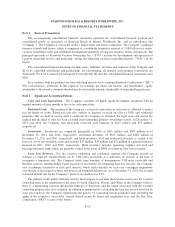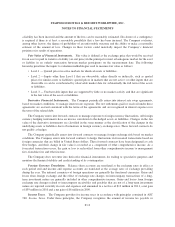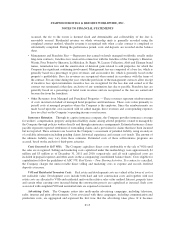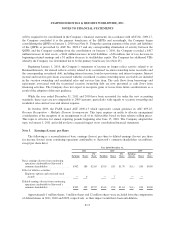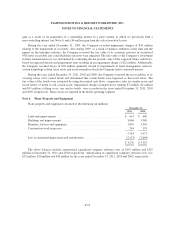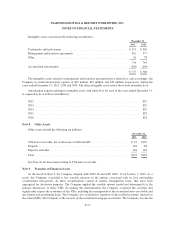Starwood 2011 Annual Report Download - page 131
Download and view the complete annual report
Please find page 131 of the 2011 Starwood annual report below. You can navigate through the pages in the report by either clicking on the pages listed below, or by using the keyword search tool below to find specific information within the annual report.STARWOOD HOTELS & RESORTS WORLDWIDE, INC.
NOTES TO FINANCIAL STATEMENTS
refundable for the current year and deferred tax assets and liabilities for the future tax consequences of events
that have been recognized in its financial statements or tax returns.
Deferred tax assets and liabilities are measured using enacted tax rates in effect for the year in which those
temporary differences are expected to be recovered or settled. The effect on deferred tax assets and liabilities of a
change in tax rates is recognized in earnings in the period when the new rate is enacted. Deferred tax assets are
evaluated for future realization and reduced by a valuation allowance to the extent the Company believes a
portion will not be realized. The Company considers many factors when assessing the likelihood of future
realization of its deferred tax assets, including its recent cumulative earnings experience and expectations of
future taxable income by taxing jurisdiction, the carry-forward periods available to us for tax reporting purposes
and tax attributes.
The Company measures and recognizes the amount of tax benefit that should be recorded for financial
statement purposes for uncertain tax positions taken or expected to be taken in a tax return. With respect to
uncertain tax positions, the Company evaluates the recognized tax benefits for derecognition, classification,
interest and penalties, interim period accounting and disclosure requirements. Judgment is required in assessing
the future tax consequences of events that have been recognized in its financial statements or tax returns.
Stock-Based Compensation. The Company calculates the fair value of share-based awards on the date of
grant. Restricted stock awards are valued based on the share price. The Company has determined that a lattice
valuation model would provide a better estimate of the fair value of options granted under its long-term incentive
plans than a Black-Scholes model. The lattice valuation option pricing model requires the Company to estimate
key assumptions such as expected life, volatility, risk-free interest rates and dividend yield to determine the fair
value of share-based awards, based on both historical information and management decision regarding market
factors and trends. The Company amortizes the share-based compensation expense over the period that the
awards are expected to vest, net of estimated forfeitures. If the actual forfeitures differ from management
estimates, additional adjustments to compensation expense are recorded. Please refer to Note 22, Stock-Based
Compensation.
Revenue Recognition. The Company’s revenues are primarily derived from the following sources:
(1) hotel and resort revenues at the Company’s owned, leased and consolidated joint venture properties;
(2) vacation ownership and residential revenues; (3) management and franchise revenues; (4) revenues from
managed and franchised properties; and (5) other revenues which are ancillary to the Company’s operations.
Generally, revenues are recognized when the services have been rendered. Taxes collected from customers and
submitted to taxing authorities are not recorded in revenue. The following is a description of the composition of
revenues for the Company:
• Owned, Leased and Consolidated Joint Ventures — Represents revenue primarily derived from hotel
operations, including the rental of rooms and food and beverage sales, from owned, leased or
consolidated joint venture hotels and resorts. Revenue is recognized when rooms are occupied and
services have been rendered.
• Vacation Ownership and Residential — The Company recognizes sales of vacation ownership interests
when the buyer has demonstrated a sufficient level of initial and continuing investment, the period of
cancellation with refund has expired and receivables are deemed collectible. For sales that do not qualify
for full revenue recognition as the project has progressed beyond the preliminary stages but has not yet
reached completion, all revenue and profit are initially deferred and recognized in earnings through the
percentage-of-completion method. The Company has also entered into licensing agreements with third-
party developers to offer consumers branded condominiums or residences. The fees from these
arrangements are generally based on the gross sales revenue of the units sold. Residential fee revenue is
recorded in the period that a purchase and sales agreement exists, delivery of services and obligations has
F-14








